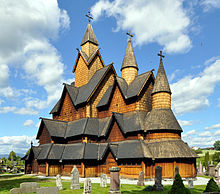
Back كنيسة هيدال الخشبية Arabic Església de fusta de Heddal Catalan Heddal stavkirke Danish Stabkirche Heddal German Iglesia de madera de Heddal Spanish هدال استاوکرک Persian Heddalin sauvakirkko Finnish Stavkirke de Heddal French Steaftsjerke fan Heddal Frisian Heddali fatemplom Hungarian
| Heddal Stave Church | |
|---|---|
| Heddal stavkyrkje | |
 View of the Heddal Stave Church (Norway's largest stave church) | |
 | |
| 59°34′46″N 9°10′34″E / 59.579568°N 9.1762321°E | |
| Location | Notodden Municipality, Telemark |
| Country | Norway |
| Denomination | Church of Norway |
| Previous denomination | Catholic Church |
| Churchmanship | Evangelical Lutheran |
| History | |
| Status | Parish church |
| Founded | c. 1200 |
| Consecrated | 25 October (year unknown) |
| Architecture | |
| Functional status | Active |
| Architectural type | Long church |
| Completed | c. 1200 |
| Specifications | |
| Capacity | 180 |
| Materials | Wood |
| Administration | |
| Diocese | Agder og Telemark |
| Deanery | Øvre Telemark prosti |
| Parish | Heddal |
| Type | Church |
| Status | Automatically protected |
| ID | 84513 |
Heddal Stave Church (Bokmål: Heddal stavkirke, Nynorsk: Heddal stavkyrkje) is a parish church of the Church of Norway in Notodden Municipality in Telemark county, Norway. It is located in the village of Heddal. It is the church for the Heddal parish which is part of the Øvre Telemark prosti (deanery) in the Diocese of Agder og Telemark. The wooden, triple nave stave church was built in a long church design around the year 1200 using plans drawn up by an unknown architect. The church seats about 180 people.[1][2]
The church is one of the 28 surviving stave churches in Norway and it is considered to be the largest of the stave churches.[3] It was constructed entirely out of wood at the beginning of the 13th century,[4] and it was dedicated to the Virgin Mary.[5] After the Reformation, the church was in very poor condition. A major restoration of the building took place during 1849–1851. However, because the restorers lacked the necessary knowledge and skills, another restoration was required in the 1950s. The interior was marked by the period after the Reformation in 1536–1537 and is for a great part a result of the restoration that took place in the 1950s.[6]
Heddal Stave Church is a popular tourist attraction, and it is open to the public during the summer season. The church is still in use, and remains a popular place to get married.[7] In the 19th century, it became one of the first stave churches to be featured in a scholarly publication, described and depicted in one of Johannes Flintoe's illustrations.[8]
- ^ "Heddal stavkyrkje". Kirkesøk: Kirkebyggdatabasen. Retrieved 2 December 2022.
- ^ "Oversikt over Nåværende Kirker" (in Norwegian). KirkeKonsulenten.no. Retrieved 2 December 2022.
- ^ Catto, Susan (9 January 2005). "Q&A". New York Times. ProQuest 432960773.
- ^ Dayani, Alison (15 October 2008). "There's Norway you'd want to miss beautiful views like these: Travel The Great Escape ALISON DAYANI visits historic Telemark". Coventry Telegraph. p. 78. ProQuest 332522491.
- ^ Jones, Annette (9–14 August 2010). Portals to the Past: Distribution Patterns in Stave Church Inscriptions. Seventh International Symposium on Runes and Runic Inscriptions: Runes in Context. Oslo, Norge.
- ^ "om-stavkirken-no – Heddal Stavkirke" (in Norwegian Bokmål). Retrieved 8 November 2022.
- ^ "Travel Tip: Heddal Stave Church – The Norway Guide". thenorwayguide.com. 9 June 2022. Retrieved 8 November 2022.
- ^ Szilágyi, Kata; Sand-Eriksen, Anette (2021). "Medieval Norwegian Wooden (Stave) Churches: Built Heritage and Places of Memory". Hungarian Archaeology. 10 (1): 30–40. doi:10.36338/ha.2021.1.5. S2CID 234900924.
© MMXXIII Rich X Search. We shall prevail. All rights reserved. Rich X Search